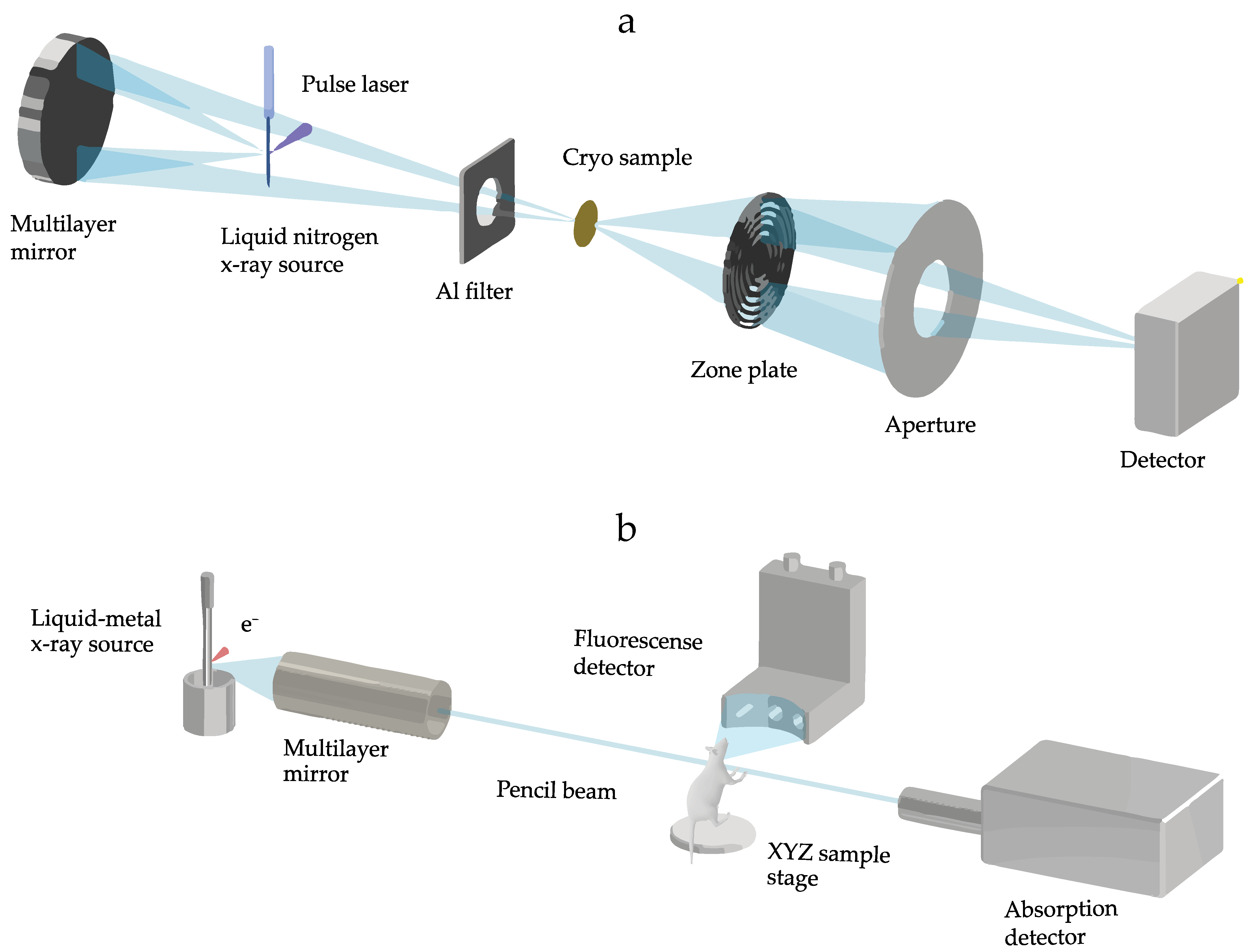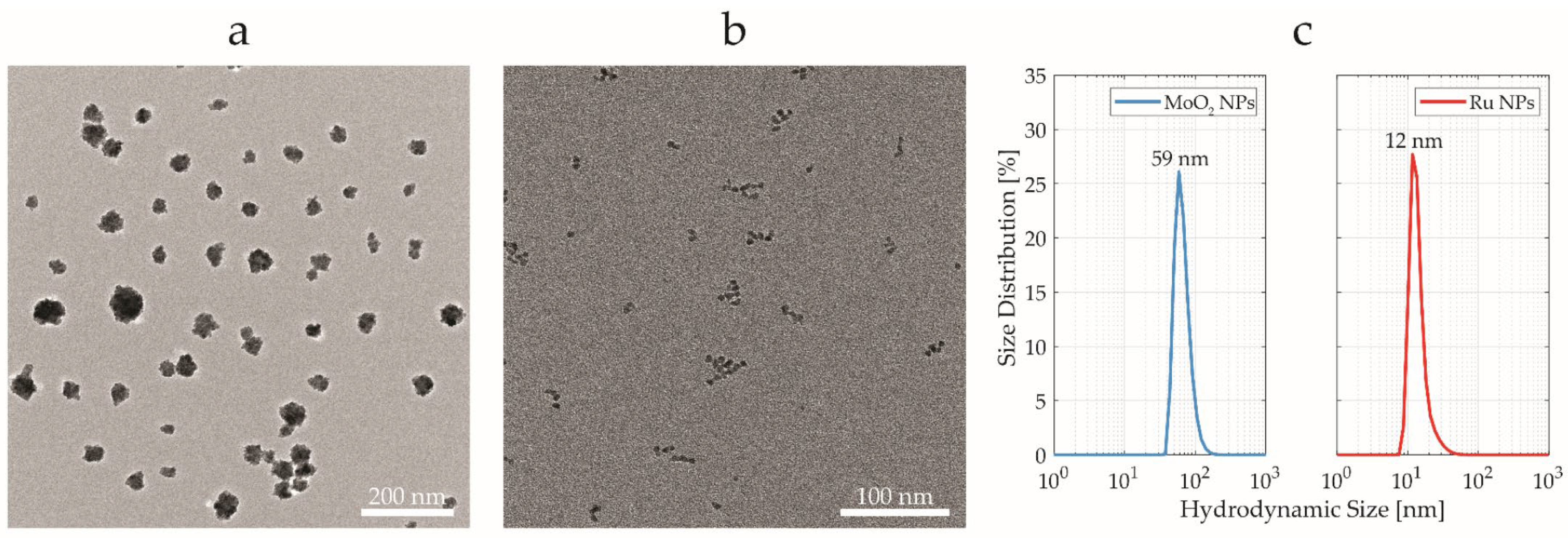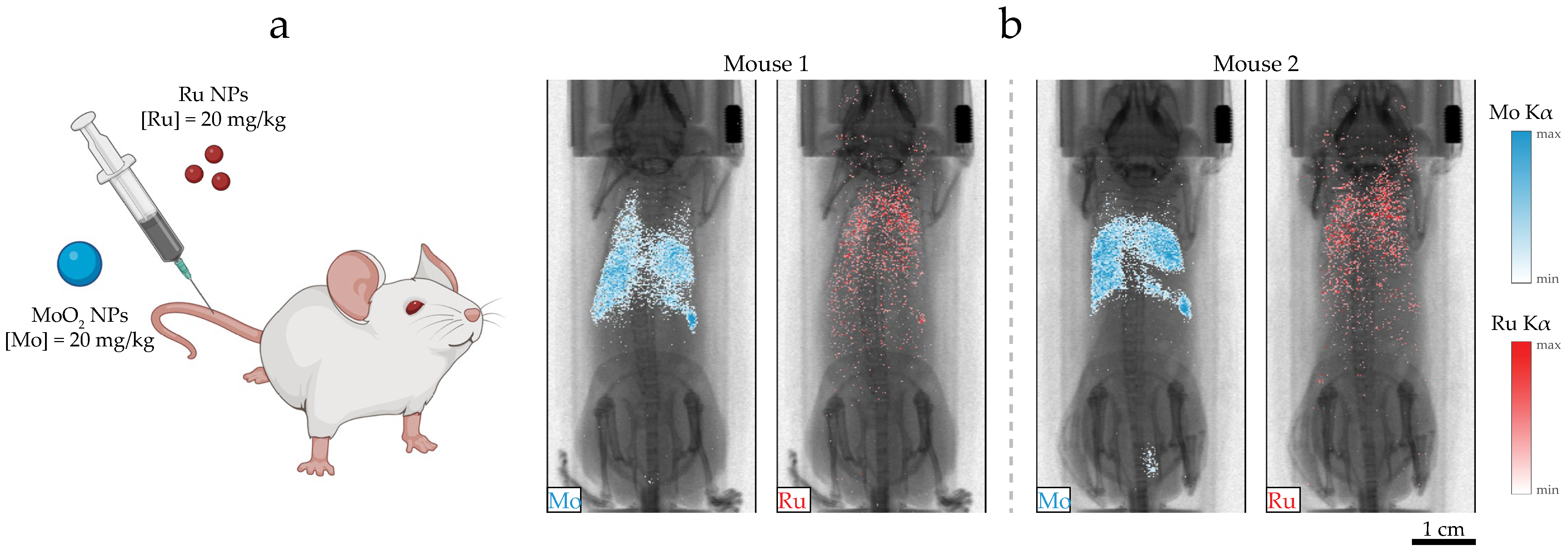Laboratory Liquid-Jet X-ray Microscopy and X-ray Fluorescence Imaging for Biomedical Applications
Abstract
1. Introduction
2. Results and Discussion
2.1. Liquid-Jet X-ray Sources
2.2. Nanoparticle Design
2.3. In Vitro X-ray Microscopy Imaging
2.4. In Vivo X-ray Fluorescence Imaging
3. Materials and Methods
3.1. Materials
3.2. Nanoparticle Synthesis
3.3. Characterization Techniques
3.4. Cell Studies
3.5. Animal Studies
4. Conclusions
Author Contributions
Funding
Institutional Review Board Statement
Informed Consent Statement
Data Availability Statement
Acknowledgments
Conflicts of Interest
References
- Zupin, L.; Pascolo, L.; Gianoncelli, A.; Gariani, G.; Luppi, S.; Giolo, E.; Ricci, G. Synchrotron radiation soft X-ray microscopy and low energy X-ray fluorescence to reveal elemental changes in spermatozoa treated with photobiomodulation therapy. Anal. Methods 2020, 12, 3691–3696. [Google Scholar] [CrossRef] [PubMed]
- Okolo, C.A. A guide into the world of high-resolution 3D imaging: The case of soft X-ray tomography for the life sciences. Biochem. Soc. Trans. 2022, 50, 649–663. [Google Scholar] [CrossRef]
- Nahas, K.L.; Connor, V.; Scherer, K.M.; Kaminski, C.F.; Harkiolaki, M.; Crump, C.M.; Graham, S.C. Near-native state imaging by cryo-soft-X-ray tomography reveals remodelling of multiple cellular organelles during HSV-1 infection. PLoS Pathog. 2022, 18, e1010629. [Google Scholar] [CrossRef]
- Bertilson, M.; von Hofsten, O.; Vogt, U.; Holmberg, A.; Christakou, A.E.; Hertz, H.M. Laboratory soft-X-ray microscope for cryotomography of biological specimens. Opt. Lett. 2011, 36, 2728–2730. [Google Scholar] [CrossRef] [PubMed]
- Hertz, H.; von Hofsten, O.; Bertilson, M.; Vogt, U.; Holmberg, A.; Reinspach, J.; Martz, D.; Selin, M.; Christakou, A.; Jerlström-Hultqvist, J.; et al. Laboratory cryo soft X-ray microscopy. J. Struct. Biol. 2012, 177, 267–272. [Google Scholar] [CrossRef]
- Sherman, S.; Kirchenbuechler, D.; Nachmias, D.; Tamir, A.; Werner, S.; Elbaum, M.; Elia, N. Resolving new ultrastructural features of cytokinetic abscission with soft-X-ray cryo-tomography. Sci. Rep. 2016, 6, 27629. [Google Scholar] [CrossRef] [PubMed]
- Kördel, M.; Dehlinger, A.; Seim, C.; Vogt, U.; Fogelqvist, E.; Sellberg, J.A.; Stiel, H.; Hertz, H.M. Laboratory water-window X-ray microscopy. Optica 2020, 7, 658–674. [Google Scholar] [CrossRef]
- Takman, P.A.C.; Stollberg, H.; Johansson, G.A.; Holmberg, A.; Lindblom, M.; Hertz, H.M. High-resolution compact X-ray microscopy. J. Microsc. 2007, 226, 175–181. [Google Scholar] [CrossRef]
- Sakdinawat, A.; Attwood, D. Nanoscale X-ray imaging. Nat. Photon. 2010, 4, 840–848. [Google Scholar] [CrossRef]
- Fogelqvist, E.; Kördel, M.; Carannante, V.; Önfelt, B.; Hertz, H.M. Laboratory cryo X-ray microscopy for 3D cell imaging. Sci. Rep. 2017, 7, 13433. [Google Scholar] [CrossRef]
- Shapiro, D.A.; Babin, S.; Celestre, R.S.; Chao, W.; Conley, R.P.; Zenes, P.; Enders, B.; Enfedaque, P.; James, S.; Joseph, J.M.; et al. An ultrahigh-resolution soft x-ray microscope for quantitative analysis of chemically heterogeneous nanomaterials. Sci. Adv. 2020, 6, 4904. [Google Scholar] [CrossRef]
- Dehlinger, A.; Seim, C.; Stiel, H.; Twamley, S.; Ludwig, A.; Kördel, M.; Grötzsch, D.; Rehbein, S.; Kanngießer, B. Laboratory Soft X-Ray Microscopy with an Integrated Visible-Light Microscope-Correlative Workflow for Faster 3D Cell Imaging. Microsc Microanal. 2020, 26, 1124–1132. [Google Scholar] [CrossRef]
- Pereiro, E. Correlative cryo-soft X-ray tomography of cells. Biophys. Rev. 2019, 11, 529–530. [Google Scholar] [CrossRef]
- Kördel, M.; Svenda, M.; Reddy, H.K.N.; Fogelqvist, E.; Arsana, K.G.Y.; Hamawandi, B.; Toprak, M.S.; Hertz, H.M.; Sellberg, J.A. Quantitative conversion of biomass in giant DNA virus infection. Sci. Rep. 2021, 11, 5025. [Google Scholar] [CrossRef]
- Okolo, C.A.; Kounatidis, I.; Groen, J.; Nahas, K.L.; Balint, S.; Fish, T.M.; Koronfel, M.A.; Cortajarena, A.L.; Dobbie, I.M.; Pereiro, E.; et al. Sample preparation strategies for efficient correlation of 3D SIM and soft X-ray tomography data at cryogenic temperatures. Nat. Protoc. 2021, 16, 2851–2885. [Google Scholar] [CrossRef]
- Graham, L.; Orenstein, J. Processing tissue and cells for transmission electron microscopy in diagnostic pathology and research. Nat. Protoc. 2007, 2, 2439–2450. [Google Scholar] [CrossRef]
- Körnig, C.; Staufer, T.; Schmutzler, O.; Bedke, T.; Machicote, A.; Liu, B.; Liu, Y.; Gargioni, E.; Feliu, N.; Parak, W.J.; et al. In-situ x-ray fluorescence imaging of the endogenous iodine distribution in murine thyroids. Sci. Rep. 2022, 12, 2903. [Google Scholar] [CrossRef]
- Pedrosa, P.; Baptista, P.V.; Fernandes, A.R.; Guerra, M. Benchtop X-ray fluorescence imaging as a tool to study gold nanoparticle penetration in 3D cancer spheroids. RSC Adv. 2021, 11, 26344–26353. [Google Scholar] [CrossRef]
- Manohar, N.; Reynoso, F.J.; Diagaradjane, P.; Krishnan, S.; Cho, S.H. Quantitative imaging of gold nanoparticle distribution in a tumor-bearing mouse using benchtop X-ray fluorescence computed tomography. Sci. Rep. 2016, 6, 22079. [Google Scholar] [CrossRef]
- Zhang, S.; Li, L.; Chen, J.; Chen, Z.; Zhang, W.; Lu, H. Quantitative Imaging of Gd Nanoparticles in Mice Using Benchtop Cone-Beam X-ray Fluorescence Computed Tomography System. Int. J. Mol. Sci. 2019, 20, 2315. [Google Scholar] [CrossRef]
- Jung, S.; Kim, T.; Lee, W.; Kim, H.; Kim, H.S.; Im, H.-J.; Ye, S.-J. Dynamic in Vivo X-ray Fluorescence Imaging of Gold in Living Mice Exposed to Gold Nanoparticles. IEEE Trans. Med. Imaging 2020, 39, 526–533. [Google Scholar] [CrossRef]
- Shaker, K.; Vogt, C.; Katsu-Jimenez, Y.; Kuiper, R.V.; Andersson, K.; Li, Y.; Larsson, J.C.; Rodriguez-Garcia, A.; Toprak, M.S.; Arsenian-Henriksson, M.; et al. Longitudinal In-Vivo X-ray Fluorescence Computed Tomography with Molybdenum Nanoparticles. IEEE Trans. Med. Imaging 2020, 39, 3910–3919. [Google Scholar] [CrossRef]
- Vogt, C.; Saladino, G.M.; Shaker, K.; Arsenian-Henriksson, M.; Hertz, H.M.; Toprak, M.S.; Brodin, B.A. Organ uptake, toxicity and skin clearance of ruthenium contrast agents monitored in vivo by X-ray fluorescence. Nanomedicine 2023, 18, 1135–1222. [Google Scholar] [CrossRef] [PubMed]
- Staufer, T.; Grüner, F. Review of Development and Recent Advances in Biomedical X-ray Fluorescence Imaging. Int. J. Mol. Sci. 2023, 24, 10990. [Google Scholar] [CrossRef] [PubMed]
- Hertz, H.M.; Larsson, J.C.; Lundström, U.; Larsson, D.H.; Vogt, C. Laboratory X-ray fluorescence tomography for high-resolution nanoparticle bio-imaging. Opt. Lett. 2014, 39, 2790. [Google Scholar] [CrossRef]
- Saladino, G.M.; Vogt, C.; Li, Y.; Shaker, K.; Brodin, B.; Svenda, M.; Hertz, H.M.; Toprak, M.S. Optical and X-ray Fluorescent Nanoparticles for Dual Mode Bioimaging. ACS Nano 2021, 15, 5077–5085. [Google Scholar] [CrossRef]
- Zhang, C.; Wu, Z.; Dang, Z.; Tian, L.; Guan, Y.; Liu, G.; Tian, Y. On-Line Fluorescence Microscopy for Identification and Imaging of Apoptotic Cell with Synchrotron-Based Soft X-ray Tomography. Micromachines 2023, 14, 326. [Google Scholar] [CrossRef]
- Boisseau, P.; Grodzins, L. Fluorescence tomography using synchrotron radiation at the NSLS. Hyperfine Interact. 1987, 33, 283–292. [Google Scholar] [CrossRef]
- Loconte, V.; Chen, J.H.; Cortese, M.; Ekman, A.; Le Gros, M.A.; Larabell, C.; Bartenschlager, R.; Weinhardt, V. Using soft X-ray tomography for rapid whole-cell quantitative imaging of SARS-CoV-2-infected cells. Cell Rep. Met. 2021, 7, 100117. [Google Scholar] [CrossRef]
- Müller, W.G.; Heymann, J.B.; Nagashima, K.; Guttmann, P.; Werner, S.; Rehbein, S.; Schneider, G.; McNally, J.G. Towards an atlas of mammalian cell ultrastructure by cryo soft X-ray tomography. J. Struct. Biol. 2012, 177, 179–192. [Google Scholar] [CrossRef]
- Chen, H.-Y.; Chiang, D.M.-L.; Lin, Z.-J.; Hsieh, C.-C.; Yin, G.-C.; Weng, I.-C.; Guttermann, P.; Werner, S.; Henzler, K.; Schneider, G.; et al. Nanoimaging granule dynamics and subcellular structures in activated mast cells using soft X-ray tomography. Sci. Rep. 2016, 6, 34879. [Google Scholar] [CrossRef]
- Chiappi, M.; Conesa, J.J.; Pereiro, E.; Sorzano, C.O.S.; Rodríguez, M.J.; Henzler, K.; Schneider, G.; Chichón, F.J.; Carrascosa, J.L. Cryo-soft X-ray tomography as a quantitative three-dimensional tool to model nanoparticle:cell interaction. J. Nanobiotechnol. 2016, 14, 15. [Google Scholar] [CrossRef]
- Bonany, M.; Pérez-Berná, A.J.; Dučić, T.; Pereiro, E.; Martin-Gómez, H.; Mas-Moruno, C.; van Rijt, S.; Zhao, Z.; Espanol, M.; Ginebra, M.-P. Hydroxyapatite nanoparticles-cell interaction: New approaches to disclose the fate of membrane-bound and internalised nanoparticles. Biomater. Adv. 2022, 142, 213148. [Google Scholar] [CrossRef]
- Kopittke, P.M.; Punshon, T.; Paterson, D.J.; Tappero, R.V.; Wang, P.; Blamey, F.P.C.; van der Ent, A.; Lombi, E. Synchrotron-Based X-Ray Fluorescence Microscopy as a Technique for Imaging of Elements in Plants. Plant Physiol. 2018, 178, 507–523. [Google Scholar] [CrossRef]
- Staufer, T.; Körnig, C.; Liu, B.; Liu, Y.; Lanzloth, C.; Schmutzler, O.; Bedke, T.; Machicote, A.; Parak, W.J.; Feliu, N.; et al. Enabling X-ray fluorescence imaging for in vivo immune cell tracking. Sci. Rep. 2023, 13, 11505. [Google Scholar] [CrossRef]
- Byrnes, I.; Rossbach, L.M.; Brede, D.A.; Grolimund, D.; Sanchez, D.F.; Nuyts, G.; Čuba, V.; Reinoso-Maset, E.; Salbu, B.; Janssens, K.; et al. Synchrotron-Based X-ray Fluorescence Imaging Elucidates Uranium Toxicokinetics in Daphnia magna. ACS Nano 2023, 17, 5296–5305. [Google Scholar] [CrossRef]
- Hemberg, O.; Otendal, M.; Hertz, H.M. Liquid-metal-jet anode electron-impact X-ray source. Appl. Phys. Lett. 2003, 83, 1483–1485. [Google Scholar] [CrossRef]
- Li, Y.; Saladino, G.M.; Shaker, K.; Svenda, M.; Vogt, C.; Brodin, B.; Hertz, H.M.; Toprak, M.S. Synthesis, physicochemical characterization, and cytotoxicity assessment of rh nanoparticles with different morphologies-as potential XFCT nanoprobes. Nanomaterials 2020, 10, 11505. [Google Scholar] [CrossRef]
- Saladino, G.M.; Vogt, C.; Brodin, B.; Shaker, K.; Kilic, N.I.; Andersson, K.; Arsenian-Henriksson, M.; Toprak, M.S.; Hertz, H.M. XFCT-MRI hybrid multimodal contrast agents for complementary imaging. Nanoscale 2022, 15, 2214–2222. [Google Scholar] [CrossRef]
- Vogt, U.; Hertz, H.M.; Bertilson, M.; von Hofsten, O.; Holmberg, A. High-resolution computed tomography with a compact soft X-ray microscope. Opt. Express 2009, 17, 11057–11065. [Google Scholar]
- Li, Y.; Shaker, K.; Larsson, J.C.; Vogt, C.; Hertz, H.M.; Toprak, M.S. A library of potential nanoparticle contrast agents for X-ray fluorescence tomography bioimaging. Contrast Media Mol. Imaging 2018, 2018, 8174820. [Google Scholar] [CrossRef] [PubMed]
- Larsson, J.C.; Vogt, C.; Vågberg, W.; Toprak, M.S.; Dzieran, J.; Arsenian-Henriksson, M.; Hertz, H.M. High-spatial-resolution X-ray fluorescence tomography with spectrally matched nanoparticles. Phys. Med. Biol. 2018, 63, 164001. [Google Scholar] [CrossRef] [PubMed]
- Gustafson, H.H.; Holt-Casper, D.; Grainger, D.W.; Ghandehari, H. Nanoparticle uptake: The phagocyte problem. Nano Today 2015, 10, 487–510. [Google Scholar] [CrossRef]
- Ngo, W.; Ahmed, S.; Blackadar, C.; Bussin, B.; Ji, Q.; Mladjenovic, S.M.; Sepahi, Z.; Chan, W.C. Why nanoparticles prefer liver macrophage cell uptake in vivo. Adv. Drug Deliv. Rev. 2022, 185, 114238. [Google Scholar] [CrossRef]
- Kördel, M.; Arsana, K.G.Y.; Hertz, H.M.; Vogt, U. Stability investigation of a cryo soft X-ray microscope by fiber interferometry. Rev. Sci. Instrum. 2020, 91, 023701. [Google Scholar] [CrossRef] [PubMed]
- Young, R.; Francis, S. Pharmacognosy: Fundamentals, Applications and Strategies; Elsevier: Oxford, UK, 2017; pp. 459–475. [Google Scholar]
- Saladino, G.M.; Kakadiya, R.; Ansari, S.R.; Teleki, A.; Toprak, M.S. Magnetoresponsive fluorescent core-shell nanoclusters for biomedical applications. Nanoscale Adv. 2023, 5, 1323–1330. [Google Scholar] [CrossRef] [PubMed]
- Josephson, L.; Kircher, M.F.; Mahmood, U.; Tang, Y.; Weissleder, R. Near-Infrared Fluorescent Nanoparticles as Combined MR/Optical Imaging Probes. Bioconjug. Chem. 2002, 13, 554–560. [Google Scholar] [CrossRef]
- Saladino, G.M.; Hamawandi, B.; Demir, M.A.; Yazgan, I.; Toprak, M.S. A versatile strategy to synthesize sugar ligand coated superparamagnetic iron oxide nanoparticles and investigation of their antibacterial activity. Colloids Surf. A Physicochem. Eng. Asp. 2021, 613, 126086. [Google Scholar] [CrossRef]
- Saladino, G.M.; Kilic, N.I.; Brodin, B.; Hamawandi, B.; Yazgan, I.; Hertz, H.M.; Toprak, M.S. Carbon quantum dots conjugated rhodium nanoparticles as hybrid multimodal contrast agents. Nanomaterials 2021, 11, 2165. [Google Scholar] [CrossRef]
- Kilic, N.I.; Saladino, G.M.; Johansson, S.; Shen, R.; McDorman, C.; Toprak, M.S.; Johansson, S. Two-Photon Polymerization Printing with High Metal Nanoparticle Loading. ACS Appl. Mater. Interfaces 2023, 15, 49794–49804. [Google Scholar] [CrossRef]
- Mikla, V.I. Medical Imaging Technology; Elsevier: Oxford, UK, 2013; pp. 1–141. [Google Scholar]






| Soft X-ray Microscopy | X-ray Fluorescence Imaging | |
|---|---|---|
| Source Energy | 0.5 keV | 24 keV |
| Imaging Mode | Full Field | Scanning |
| Liquid-Jet Material | Liquid Nitrogen | Galinstan (Metal Alloy) |
| Contrast | Photoelectric Absorption | Kα Fluorescence Emission |
| Application | Cellular Imaging | Animal Imaging |
Disclaimer/Publisher’s Note: The statements, opinions and data contained in all publications are solely those of the individual author(s) and contributor(s) and not of MDPI and/or the editor(s). MDPI and/or the editor(s) disclaim responsibility for any injury to people or property resulting from any ideas, methods, instructions or products referred to in the content. |
© 2024 by the authors. Licensee MDPI, Basel, Switzerland. This article is an open access article distributed under the terms and conditions of the Creative Commons Attribution (CC BY) license (https://creativecommons.org/licenses/by/4.0/).
Share and Cite
Arsana, K.G.Y.; Saladino, G.M.; Brodin, B.; Toprak, M.S.; Hertz, H.M. Laboratory Liquid-Jet X-ray Microscopy and X-ray Fluorescence Imaging for Biomedical Applications. Int. J. Mol. Sci. 2024, 25, 920. https://doi.org/10.3390/ijms25020920
Arsana KGY, Saladino GM, Brodin B, Toprak MS, Hertz HM. Laboratory Liquid-Jet X-ray Microscopy and X-ray Fluorescence Imaging for Biomedical Applications. International Journal of Molecular Sciences. 2024; 25(2):920. https://doi.org/10.3390/ijms25020920
Chicago/Turabian StyleArsana, Komang G. Y., Giovanni M. Saladino, Bertha Brodin, Muhammet S. Toprak, and Hans M. Hertz. 2024. "Laboratory Liquid-Jet X-ray Microscopy and X-ray Fluorescence Imaging for Biomedical Applications" International Journal of Molecular Sciences 25, no. 2: 920. https://doi.org/10.3390/ijms25020920
APA StyleArsana, K. G. Y., Saladino, G. M., Brodin, B., Toprak, M. S., & Hertz, H. M. (2024). Laboratory Liquid-Jet X-ray Microscopy and X-ray Fluorescence Imaging for Biomedical Applications. International Journal of Molecular Sciences, 25(2), 920. https://doi.org/10.3390/ijms25020920








